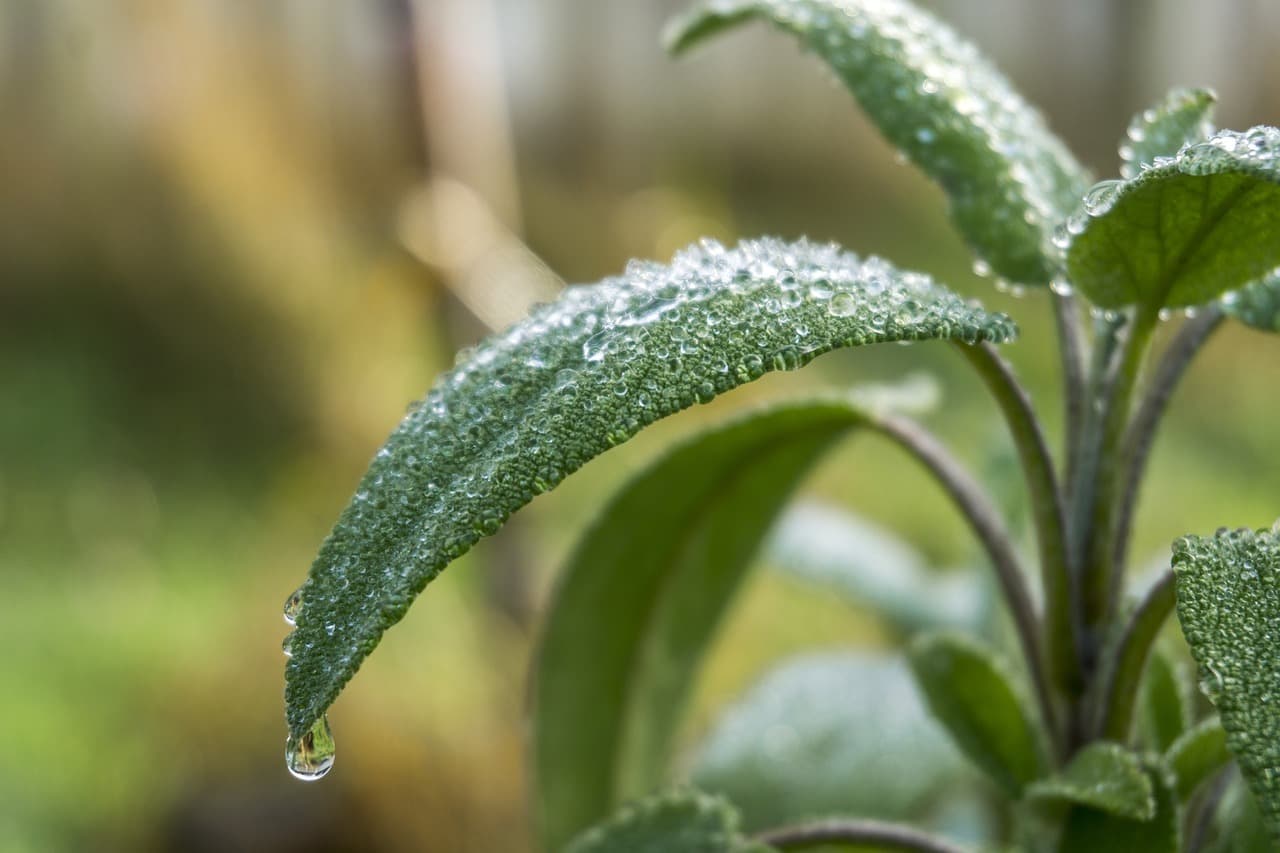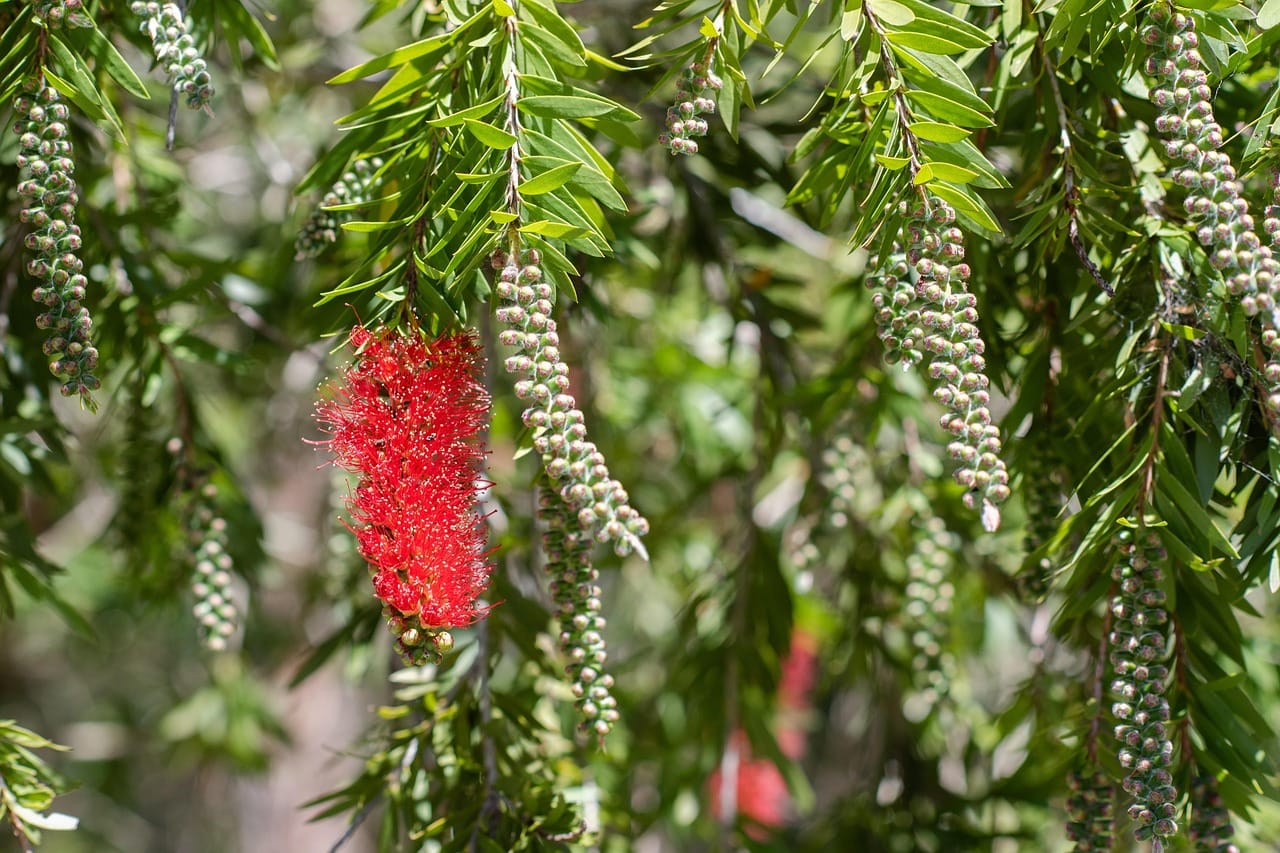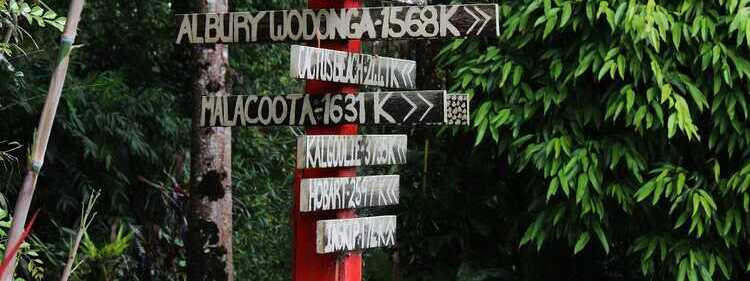
Queensland is a land of extraordinary natural beauty and ecological diversity. Known for its stunning coastlines, lush rainforests, and, of course, the Great Barrier Reef, Queensland is also home to some of the most unique flowers in the world.
This wealth of native flowers plays a crucial role in maintaining the delicate balance of the state's ecosystems, providing sustenance to countless species of wildlife while also adding vibrant splashes of colour to the landscape. Native plants are essential for protecting the local ecosystem and maintaining biodiversity. And since they’re adapted to the local environment, they grow easily, are resilient to pests, can adapt to climate change, and are efficient at using local water resources, meaning they require less water than exotic species, and have cultural significance.
In this article, we will explore the most iconic and unique native flowers of Queensland, delving into their characteristics, habitats, cultural significance, and ecological importance.
1. Cooktown Orchid (Dendrobium bigibbum)
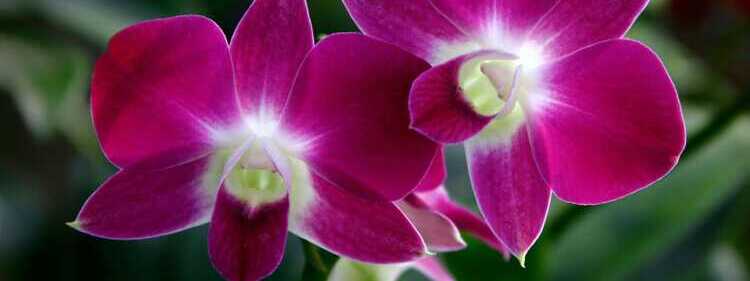
The best place to start is with the national floral emblem of Queensland. The Cooktown orchid, also known as the mauve butterfly due to the gorgeous colour and shape of its large blooms, is native to the rainforests of northern Queensland in the Cape York Peninsula. This striking flower was voted the national floral emblem of Queensland in 1959 during celebrations to mark the state’s centenary.
Most commonly producing purple, pink, or lavender flowers, the Cooktown orchid can also occur in white on rare occasions. The distinct two-lipped structure of this plant’s flowers makes it stand out from other orchids and the lower lip’s colour is often a more vibrant shade than the upper one. Flowering takes place once a year in its natural habitat, either in the spring or summer, depending on the climate, and can last two to three months.
An epiphytic orchid, meaning that it typically grows on trees in its natural habitat, the Cooktown orchid has aerial roots that help it absorb nutrients and moisture from the air, rain, fog, and organic matter. It also produces pseudobulbs that store its energy and moisture.
A slow-growing evergreen orchid, this popular ornamental can reach up to about 1.5 metres high and this usually takes 5 to 10 years. It works well as a houseplant and thrives in warm, humid environments. The best way to propagate the Cooktown orchid is through division, once the plant has reached maturity, or by removing and planting the side shoots that develop on a mature plant’s pseudobulbs.
2. The Brisbane Lily (Proiphys cunninghamii)
The delicate, creamy white blooms of this unassuming flower are captivating in their simplicity. Felt by some gardening enthusiasts to be the more suitable floral emblem of Brisbane, the Brisbane lily produces between 5 to 12 trumpet-shaped flowers on its long, single stalk that grows from its centre. Held up by slender vibrant green pedicels that add to the flowers’ delicate appearance, the plant grows well in shade between the spring and summer months,
The Brisbane lily, also known as the Moreton Bay lily, grows to around 30 to 60 cm tall and is naturally found in moist, shaded areas, such as rainforests and their outskirts, in southeastern Queensland. However, it is also easy to grow at home and thrives in indoor environments. But for some reason, it’s not commonly cultivated. Named after the botanist to first document it, Allan Cunningham, this perennial has a slight fragrance that attracts a variety of pollinators.
The plant is typically flanked by large, glossy leaves that can grow as long as 30 cm and 35 cm wide, and that die back in the wintertime. The large size of the leaves is another indicator of the flower’s habitat as plants with large leaves are often found in environments that are humid, shaded, and wet because they are able to capture more sunlight and find it easier to keep cool.
3. Common Swamp Orchid (Phaius australis)
Bearing a name that obscures its beauty, is an extraordinary plant. The habitat of this evergreen terrestrial, which is indeed swampy forests along the Queensland coast, is probably the least interesting part of this remarkable plant. It's believed to be the tallest orchid in Australia, reaching anywhere between up to 2 metres tall and its flowers are the largest of any Australian orchid.
The common swamp orchid was first described in 1858 by the German-Australian botanist, Ferdinand von Mueller, who was also the director of the Royal Botanic Gardens in Melbourne. However, over time, due to its unique and attractive characteristics, it’s now listed as an endangered species under the Australian Government's Environment Protection and Biodiversity Conservation (EPBC) Act. This category indicates that the orchid is facing a “very high risk of extinction in the wild in the near future, typically within the next 20 years”. Its main threats are poaching and habitat loss.
Blooming in spring, the tubular flowers of this orchid are a dark reddish brown on the inside and upper half of the flower and white on the outer lower half. A close relative of the swamp orchid, the Yellow Swamp Orchid, which produces spectacular large yellow flowers, shares many of the characteristics of the common swamp orchid, such as the capacity to grow up to 2 metres and being endangered. Between 1992 and 2007, the Yellow swamp orchid was recorded as occurring in only one area on Stradbroke Island, near Myora in Queensland.
4. Hop Goodenia (Goodenia ovata)
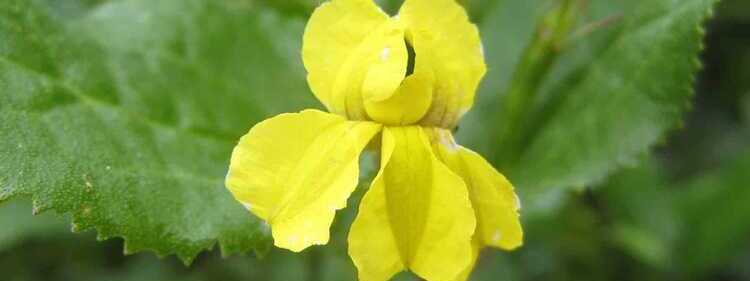
Photo by 阿橋花譜 HQ Flower Guide
Characterised by its clusters of cheerful yellow flowers, Hop Goodenia commonly grows in semi-shaded, partially moist areas, such as forests and river banks, in southeastern Queensland. Its flowers are around 2 to 3 cm long and, depending on climate and location, usually start making an appearance in winter or spring and last for several weeks.
Although not widely cultivated or favoured as an ornamental plant due to its potentially unruly appearance, Hop Goodenia does clean up pretty well when pruned hard and consistently. Once established, they are hardy and drought-tolerant and are known to even be salt-tolerant, making them ideal for planting in coastal areas. In a home garden, it works well as a hedge, border, or ground cover and can even be grown as a decorative hanging basket flower.
Scientifically known as Goodenia ovata, the Hop Goodenia was named after the amateur 19th botanist British botanist, Samuel Goodenough who was also the Bishop of Carlisle. The Latin word ovata means egg-shaped, which is in reference to the shape of the plant’s leaves, which grow to about 10 cm long and have a glossy, leathery texture that helps the plant retain moisture.
A resilient and low-maintenance plant, Hop Goodenia is known to spring up quite profusely after a bushfire. Easy to propagate from cuttings, it grows quickly and easily, often reaching up to 2 metres high and about 1.5 metres wide.
5. Slender Rice Flower (Pimelea linifolia)
A well-trimmed Slender rice flower plant in the garden is quite a sight to behold. It grows as a dense, compact shrub that produces small clusters of white, hairy flowers that pepper the entirety of the dark green thicket. The tiny flower petals, which look like grains of white rice - hence the name - sit atop floral bracts that flare outward in a star shape.
Flowering usually takes place from spring to early summer, although sporadic blooming can occur outside this period. Widely cultivated and appreciated for their ornamental value, Slender Rice Flowers don’t grow very tall, reaching only about 1 metre in height. It's found mostly in woodlands and open forests and prefers subtropical to temperate climates. Its glossy leaves help it to tolerate dry conditions relatively well, making it low maintenance and hardy.
The Pimelea linifolia’s distinct leaves, which are long and narrow, resemble those of flax and have subsequently earned the plant the additional nickname of Flax-leaf Pimelea. Pimeleas are unfortunately known to be toxic to livestock, particularly sheep and cattle, causing what’s known as pimelea poisoning or "bush sickness”, and can cause death in severely affected animals. It’s not confirmed whether the Pimelea linifolia itself is toxic to livestock, but if you own
Historically and culturally, the bark of the Pimelea linifolia was known as the 'Bushman's Bootlace’ and was used to make string. While it’s possible to propagate the plant from cuttings, it’s quite difficult to do so from seed.
6. Silky Purple Flag (Patersonia sericea)
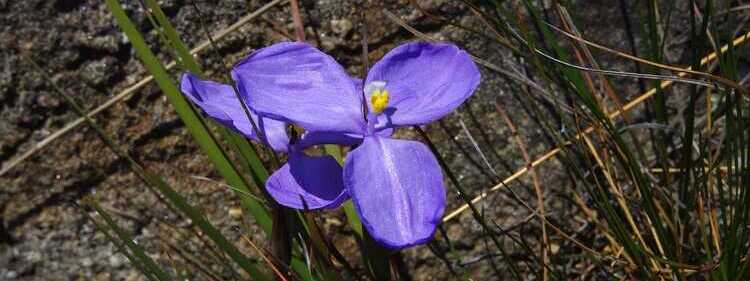
Image by John Merriman/Flickr
One of the secrets to the resilience and hardiness of Silky Purple Flags is that they grow from rhizomes, which are stems that continuously grow underground. Rhizomes enable plants to survive unfavourable seasons, which is why Silky Purple Flags are known for growing abundantly in fire-prone areas since they easily regenerate afterwards. As a result, Patersonia sericeas play a crucial ecological role in fire-prone ecosystems.
Easily identifiable by its deep purple flowers and striking yellow stamens, Silky Purple Flags are cultivated as ornamental plants and they do well in gardens. In the wild, this perennial is found mostly on the coast and it thrives in temperate climates. Classified as a native iris, Patersonia sericeas bloom during the winter and throughout spring and its flowers are pretty large, usually between 5 to 7 cm wide. They grow in compact tufts and reach between 30 cm to 1 metre high.
The Patersonia sericea is named after the Scottish botanist and explorer, William Paterson, and the word sericea is derived from the Latin word for silky. This is in reference to the silky smooth texture of its foliage, which can grow pretty long - from 30 cm to 70 cm in length. There are two types of Patersonia sericea, with the main difference being in their foliage width: the longifolia variety has 2 mm wide leaves while the sericea variety has 6 mm wide leaves.
7. Hairy Bush Pea (Pultenaea villosa)
At the height of its flowering period, the Hairy Bush Pea is a vision to behold. Bursting with colour from the hundreds of golden-yellow flowers that it produces along every stem, providing a striking contrast against the plant’s dense foliage. Flowering starts in spring and lasts until summer, and the blooms are known to attract birds, butterflies, and bees.
All 120 species of Pultenaea are endemic to Australia and are known to be difficult to grow in a garden setting. However, the Pultenaea villosa has proved to be the exception. Cultivated for years, Hairy Bush Peas work well as a feature plant in a garden setting or it can alternatively add great interest as a hedge. In the wild, Hairy Bush Peas tend to grow in well-drained locations, such as grasslands, coastal dunes, and dry forest areas.
The Pultenaea villosa was named after the English physician and botanist Richard Pulteney who is also known for publishing the first English language biography of the Swedish scientist, Carl Linnaeus, who officially devised the modern system of naming organisms. Pultenaea villosa can reach 2 metres tall and 2.5 metres wide and once fully grown the ends of its branches hang down in an elegant weeping manner.
8. Fairy Fan-flower (Scaevola aemula)
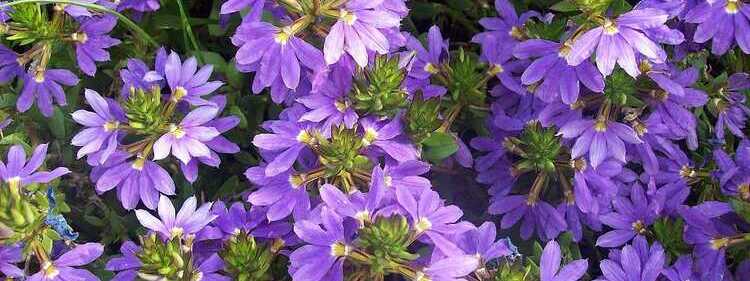
Photo by By Nemracc- Own work, CC BY-SA 3.0
It’s not easy to describe the Scaevola aemula in a way that fully captures its striking beauty when in bloom. Commonly known as the fairy fan flower, due to its distinctive clusters of flowers that spread outward in a fan-like shape, the Scaevola aemula comes in purple and blue colours. When in full bloom, the flowers almost completely cover the plant - a breathtaking sight.
The fairy fan-flower is a popular choice in landscaping due to its eye-catching flowers, compact growth habit, and hardiness. Cultivated widely as an ornamental, this perennial is incredibly versatile and looks stunning pretty much anywhere in the garden. It grows well in pots, hanging baskets, in a garden bed, as a hedge, or anything else you can think of. Some fairy fan-flowers have been bred for larger flowers, colour, or more compact growth. Popular cultivars include Scaevola aemula 'Whirlwind' and Scaevola aemula 'Blue Fan', which are known for their bright flower colour and prolific blooming.
The Scottish botanist, Robert Brown, is the first person known to have formally described the fairy fan flower in the early 19th century, and its scientific name roughly translates to “imitating the left hand” because of the shape of the plant’s corolla. Flowering from the end of winter and throughout spring, the fairy fan-flower can reach 1.5 metres high and 2 metres wide. In nature, the fairy fan flower is found along the coastlines and in sandy soils in southeast Queensland.
9. Bower of Beauty (Pandorea jasminoides)
The common name of this evergreen plant tells you a lot about its visual appeal. Native to eastern Queensland, the Bower of Beauty is a prolific bloomer producing vibrant bell-shaped white or pink flowers with dark red or white centres. A very fast-growing vine, it can quickly climb and cover fences, trellises, arbors, and pergolas within one to two growing seasons.
While not frost-tolerant, especially when first planted, the Bower of Beauty requires little to no maintenance once established. It has been widely bred to produce multiple cultivars, such the ‘Funky Bellz’ variety, which has large pink flowers with a white centre, Pandorea jasminoides ‘Southern Belle’, which has pink flowers with a dark pink centre, and the Pandorea jasminoides ‘Alba’, which has a white flowers and a white centre.
The Bower of Beauty was first named Tecoma jasminoides by the Scottish botanist George Don in the mid-19th century, with Tecoma meaning tubular in the Aztec language referring to the shape of the flowers. But, 57 years later, the German botanist, Karl Moritz Schumann changed the name to Pandorea jasminoides after Pandora’s box in Greek mythology due to the number of seeds released when the plant’s fruit is opened.
10. Hairy Guinea Flower (Hibbertia vestita)
Primarily found in the coastal and inland regions of Queensland, the Hairy guinea flower is a woody evergreen shrub that’s endemic to Australia. Drought-tolerant and hardy, it usually grows only 30 cm high and up to 50 cm wide. The Hibbertia vestita produces delightfully bright yellow flowers that are about 25 mm wide from spring all the way to autumn.
Hibbertias get their common name from their flowers’ resemblance to the ancient golden guinea coin. Interestingly, the Hibbertia vestita is often confused with the Hibbertia serpyllifolia due to their considerable similarities in all other areas except for their growing habits. While vestitas are compact and don’t spread very far, the serpyllifolia is a groundcover that spreads great distances. Therefore, to achieve a dense look with vestitas in a garden setting, for an attractive border or hedge, it’s advisable to plant several of them together.
The best way to propagate the Hibbertia vestita is through cuttings in early spring before flowers appear. It is estimated that there are between 115 to 150 species of Hibbertia, of which approximately 90% are endemic to Australia. Some like Hibbertia dentata are trailing plants, which make them suitable for hanging baskets, while Hibbertia scandens is a climber and so would work well as a cover for a trellis or fence.
11. Byfield Spider Flower (Grevillea venusta) - vulnerable
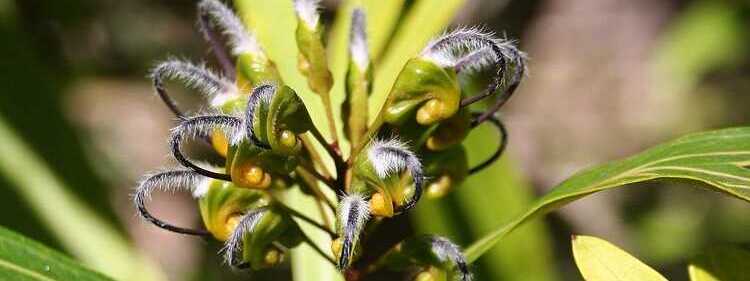
Photo by Casliber - Own work, Public Domain,
The intricately shaped flowers of the Grevillea venusta are one of its most distinguishing features. Also known as the Byfield spider flower or the Showy Grevillea, due to its unique blooms, the Grevillea venusta occurs natively in the Byfield area of Queensland. So taken by its appearance, it seems, was the botanist who first described it, Robert Brown, that he gave it the Latin name of venusta, which means “charming, lovely or graceful”.
The flowers of the Grevillea venusta are nectar-rich and particularly important for native nectarivorous birds and insects. Traditionally, Grevillea flowers were also used by the First Nations Peoples for their nectar - either consumed directly as it is or mixed with water as a drink. The Grevillea venusta’s flowers range from vibrant green and yellow to an orange-red colour and they make an appearance in spring all the way to summer.
Growing up to 5 metres tall and wide, this plant grows well in a warm, sunny environment and doesn’t tolerate frost well. Due to its minimal occurrence in the wild and the potential threats of timber harvesting and habitat loss, the Grevillea venusta is listed as vulnerable under the Queensland Nature Conservation Act 1992. It can be propagated through cuttings, grafting, and seed.
12. Koala Bells (Artanema fimbriatum)
The common name of this perennial elicits a whimsical image of koalas ringing these blue tubular-shaped blooms. Koala Bells are known for their delicate trumpet-shaped, bluish-purple flowers that have fringed edges, hence the plant’s other given nickname of Fringed Artanema. The flowers tend to have a light-coloured centre and when in full bloom can make really eye-catching garden borders or hanging basket flowers.
A short-lived perennial, Koala bells don't have very long lifespans. They survive between 1 to 3 years and often don’t begin flowering until their second year. Their seasonal flowering period lasts from spring to early summer and their decline usually begins after producing seeds. Often found in woodlands and on hillsides, Koala bells prefer slightly wet conditions and do well in partially shaded areas.
Somewhat hardy and drought-tolerant, Koala bells’ foliage often has serrated edges and a slightly hairy texture, which helps reduce water loss and protect the plant from heat and drought. Koala bells are relatively easy to propagate, with propagation by cuttings the more straightforward method than by seed. The plant responds well to pruning, becoming thicker and bushier, but they generally don't grow very tall, reaching anywhere between 30 to 60 cm high.
13. Vine Lilac (Hardenbergia violacea)
A woody climber native to the coasts of eastern Queensland, the Vine lilac is known to climb tree trunks, trellises, fences, or walls using its tendrils. In the wild, Hardenbergia violacea is often found climbing through shrubs and low trees, using its twining stems to ascend and reach sunlight, a strategy that helps it compete for light in dense vegetation. In these natural circumstances, it is said to be able to grow up to even 15 metres tall.
However, in a garden setting, the Vine Lilacs can reach around 5 to 7 metres in length as a climber or 2 to 5 meters high when grown as a vine or shrub. The growing habit of this hardy evergreen, its dense leaf coverage, and profuse flowering have made it a popular plant for ornamental gardening. While it traditionally produces purple or violet flowers, Hardenbergia violacea has been cultivated to also come in varying shades of pink, white, lilac, and blue-purple.
As a member of the legume family, Hardenbergia violacea is capable of thriving in nutrient-poor soils due to its nitrogen-fixing ability. This makes it hardy, easy to grow, and low maintenance for gardens. Interestingly, Hardenbergia violacea was initially named Glycine violacea by the Dutch botanist, George Voorhelm Schneevoogt in 1793, but was later changed in 1940 by the British botanist, William T. Stearn, to Hardenbergia violacea, naming it after the Austrian noblewoman and botanical curator, Franziska Countess von Hardenberg.
14. Buttercup Orchid (Dendrobium agrostophyllum)
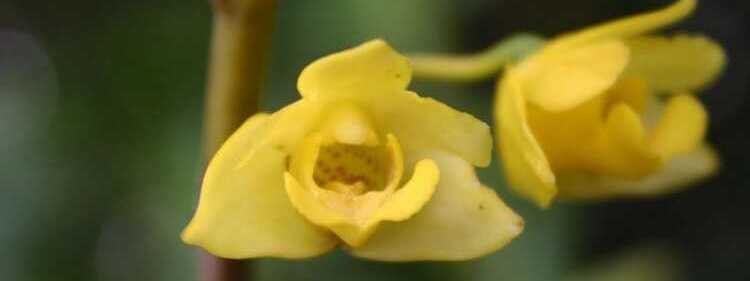
You need to be quite adventurous to come across the Buttercup orchid in its natural habitat. Not only do they tend to grow at elevations of between 700 and 1,200 metres above sea level, but they are also commonly found on the upper branches or trunks of trees, sometimes even on rocks, in shaded areas. In Queensland, they occur in the north coastal forests of the Paluma Range National Park and on the rocks of Mount Windsor National Park.
Given their growing habits, Buttercup orchids have aerial roots that help them absorb nutrients and moisture from the air, rainwater, and decaying organic matter. Due to the exposed nature of the roots, they are covered by a spongy, white tissue called velamen that serves as a protective layer, helping to prevent water loss and provide protection from excessive UV light.
Buttercup orchids produce bright yellow, waxy flowers that bloom for about two weeks, beginning from the end of winter into spring. It can grow to more than 1 metre tall. The narrow, grass-like leaves of the Buttercup orchid are one of its distinctive features compared to many other Dendrobium species, hence its scientific name agrostophyllum, which means “grass-leafed” in Greek.
15. Wallum Tea-tree (Leptospermum semibaccatum)
In the early 1930s, the Australian botanist, Edward Cheel was the first to formally give the Wallum tea tree the scientific name of Leptospermum semibaccatum. In English, Leptospermum roughly translates to slender-seeded from Greek. However, in 2023, the Australian botanists, Peter Gordon Wilson and Margaret Heslewood, recently reclassified many of the species in the Leptospermum genus into three new genera - Apectospermum, Aggreflorum, Gaudium - and reinstated another genus, Leptospermopsis. The result has been a reduction in the number of species in the Leptospermum genus from about 87 to about 34.
Consequently, the current scientific name for the Wallum tea tree is officially now Gaudium semibaccatum. However, you have heard of the Leptospermum genus in a different context as it’s commonly associated with the famous Manuka honey, which is known to be a great antimicrobial and also stimulates the body’s immune system.
The Wallum tea tree is native to the southeastern of Queensland and can be found in coastal areas such as Bundaberg. It produces flowers that are usually 1 to 2 cm wide and range from white to pale pink in colour. The flowers’ soft-textured petals are often arranged in a way that gives the flower a "star-shaped" appearance when viewed from above. The small oval-shaped leaves of the Wallum tea tree typically have a waxy or glossy texture and release the well-known tea tree scent when crushed.
16. Native Rosella (Hibiscus heterophyllus)
The large, showy flowers of the Native Rosella have probably stopped many people right in their tracks. These visually arresting blooms measure up to 15 cm in diameter and occur in white, pale pink, or yellow with a maroon centre. The flowering period starts in winter, depending on the location, and lasts throughout summer. During that time each flower lasts for about 1 to 2 days with new flowers continuously opening until the end of the season.
Native rosella grows in open forest areas along the coast of Queensland and it tends to be the yellow flower variety. It is fast-growing and can reach about 3 to 6 metres high. It gets its scientific name heterophyllus, which means “having leaves of more than one kind”, due to the varying shapes of its leaves. They can be oval, lobed, or even have up to three lobes.
Several cultivars exist, including the ‘Aussie Delight’, which produces pale pink flowers with a dark red centre and has a long flowering period. In a garden setting, native rosella can work well as hedges or fences, as well as ornamentals in landscaping or as potted plants.
Historically used for a variety of purposes, ranging from culinary to handiwork, native rosella has been a key part of many social and cultural customs. Native rosella flower buds, for instance, have been used to make jam or as a garnish. Its leaves and young shoots have been eaten as vegetables and its stems are used for making nets.
17. Musk Mallow (Abelmoschus moschatus)
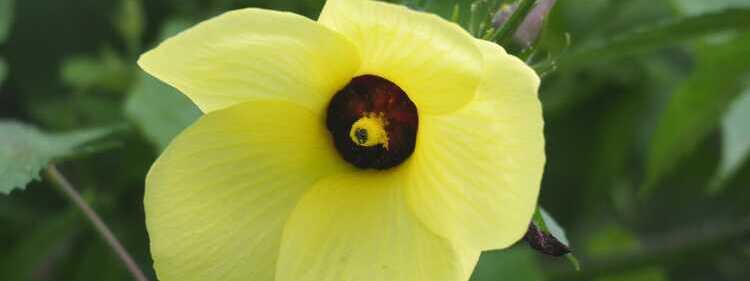
You may not have heard of the Musk Mallow before, but you’ve probably smelt it. Used in the perfume industry for centuries, its seeds contain an essential oil that has a musky fragrance and is used as a fixative in perfumes and other scented products. It’s preferred to synthetic musks because its fragrance is less overpowering, has a more natural scent, and is long-lasting, which helps to stabilise and prolong other fragrances as well.
The Musk mallow grows in northern and eastern Queensland where it can grow as a herbaceous annual or a short-lived perennial. It produces large yellow or orange flowers with a dark red centre, which measure around 6 to 8 cm in diameter, and blooming often takes place from late spring and throughout summer. The plant itself commonly reaches up to 2 metres tall and can spread to 1.5 metres wide.
In the garden, Musk mallow grows well in pots and is effective in bringing interest to garden beds and borders. It has also been used in cultural customs and traditions around the world. Some of the first official documented use was made in the 18th century by the German entomologist, Maria Sibylla Merian, who wrote about indigenous women using the seeds to make jewellery and also as chicken feed. In other parts of the world, it’s used as a spice and for medicinal purposes.
18. Queensland Bluebell (Wahlenbergia queenslandica)
Given its name, there’s little doubt about where this flower is native. Found in the dry areas of rainforests and woodlands of northeastern Queensland, the Queensland bluebell produces large, single purplish-blue flowers per stem that measure about 1.5 cm in diameter. Its blooming period starts around September and reaches its peak during early summer, from October to December.
Although the Wahlenbergia species was first named by the German botanist Heinrich Schrader in 1814, he decided to name it after Göran Wahlenberg, a Swedish botanist and professor at Uppsala University. Growing up to 1 metre high, this perennial produces flowers throughout most of the year, apart from the peak of winter, and thrives in warmer, subtropical conditions. It can grow in clusters and tends to have a spreading growth habit.
With its eye-catching blue flowers, the Queensland bluebell can be an attractive and colourful border plant in the garden. It’s hardy and low-maintenance, requiring minimal care once established. It can also withstand periods of dry weather, which makes it an ideal choice for gardeners looking for attractive plants that don't need constant attention. Although it’s not widely cultivated, it’s easy to grow and propagate the Queensland bluebell from cuttings, divisions, and seeds.
19. Fringe Lily (Thysanotus tuberosus)
The exquisite design of this tiny plant’s flowers is a breathtaking natural work of art. Growing only between 20 cm to 80 cm in height, this unique perennial produces vibrant, purple flowers with a perfect row of delicate fringe along the edges of its petals as though it was sewn on by the world’s finest tailor. In addition to purple, the fringe lily’s star-shaped flowers also bloom in various shades of pink, lilac, and mauve. They usually grow 3 to 5 cm in diameter and bloom from spring through to early summer.
Flowering occurs on a branched stem with each stem supporting around eight or more flowers. To protect itself from excess heat, the fringe lily’s flowers tend to open in the morning and close in the afternoon. Individual blooms tend to last for only one day, but the plant will continue to bear new flowers throughout its flowering period.
A resilient plant, the Fringe lily is largely found across eastern and southeastern Queensland and prefers dry forest and woodland areas. They are not commonly cultivated due to being difficult to maintain in cultivation and also perhaps not growing in the most appealing of ways, choosing to clump instead of spreading evenly. However, their roots, which are tubers, and their leaf bases are edible and have historically been used as food sources.
20. Cape York Lily (Curcuma australasica)
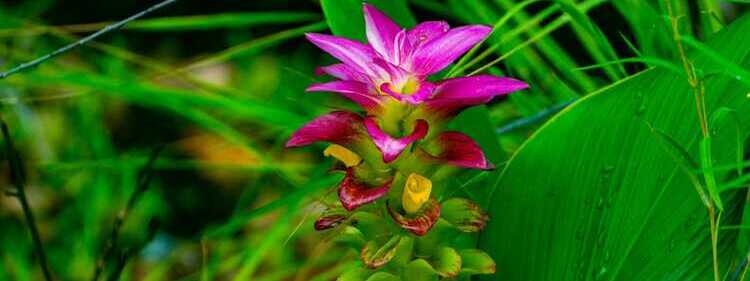
This tropical flowering plant is also known as Kumbigi in the Guugu Yimithirr language of the Guugu Yimithirr people of Far North Queensland, which was also the first Aboriginal language recorded by European settlers in Australia in 1770. Native to the Cape York Peninsula in Queensland, the Cape York lily is the only Australian native of the over 90 Curcuma species found around the world.
Curcuma australasica is a turmeric plant that produces yellow tubular flowers on an inflorescence that grows in the centre of the plant. On that same flower spike, pink, red, or green bracts grow above the flowers serving as protection for them from stressful environmental factors and pests. The flower spike can reach up to 50 cm high, creating a striking appearance when the flowers are in bloom, which occurs from summer to early autumn.
The Cape York lily is a herbaceous perennial that can grow up to 1.5 metres tall. It is known to have multiple medicinal uses and grows well in cultivation. Currently, one of the known Cape York lily cultivars is the “Aussie Plume”, which can grow to almost 2 metres high. While it prefers moist environments, it doesn’t tolerate waterlogged conditions. The roots of the plant are edible and can be used as a spice in cooking just like the common turmeric root.
21. White Paper Daisy (Coronidium elatum)
In Queensland, the Coronidium elatum is mainly found in the cooler, highland regions of the southern and southeastern parts of the state and can grow in altitudes of up to 1,300 to 1,500 metres above sea level. While it can take a year or two to establish and begin flowering, once it does the White paper daisy is a prolific bloomer. Each plant produces around 20 to 50 flower heads per season at its peak.
Commonly bearing white flowers with yellow disk florets in the centre, the White Paper Daisy’s flowering period lasts for several weeks from spring until summer. Its flower heads measure about 4 to 6 cm in diameter, while the plant itself grows between 30 to 60 cm tall on average and spreads about 30 to 45 cm wide.
Due to its showy blooms, the White Paper Daisy has been bred as an ornamental. One of the more well-known cultivars is “Sunny Side Up”, which is much shorter and more compact in comparison, growing up to 1.5 metres tall and 1 metre wide. Both varieties work well as borders in the garden, as potted plants, and in cut flower arrangements. “Sunny Side Up” will also hold up nicely as ground cover. Although they thrive in cooler, temperate climates, White Paper daisies don’t tolerate frost, and of course humid conditions, very well.
22. Arrowhead Violet (Viola betonicifolia)
Small and somewhat inconspicuous in nature, the Arrowhead Violet plays a valuable role in the conservation of the endangered Australian Fritillary butterfly. Categorised as having a 95% chance of becoming extinct in the wild in 20 years by a research study published in 2021, the Australian Fritillary relies solely on Viola betonicifolia for its food.
This perennial is native to the cooler, highland areas of Queensland, such as in Lamington National Park, and thrives in moist, partially shaded environments. Although Viola betonicifolia does attract pollinators, it has also adapted to self-pollinate through cleistogamy due to the remoteness of the habitats in which it naturally occurs as pollinators aren’t always available.
Producing small to medium-sized purple flowers typically measuring between 2 to 3 cm in diameter, the Arrowhead Violet’s flowering period takes place from spring to early summer. The colour of the flowers fades as they age, with peak flowering occurring in spring. The Arrowhead Violet gets its common name from the shape of its distinct, narrow leaves, which grow between 3 cm to 30 cm long.
The best way to propagate the Arrowhead Violet is through cuttings and root division. Once established, the plant pretty much does the rest of the work of maintaining its stock by self-sowing its seedlings into the soil at the end of its season and regrowing the following year.
23. Cat’s Whiskers (Orthosiphon aristatus)
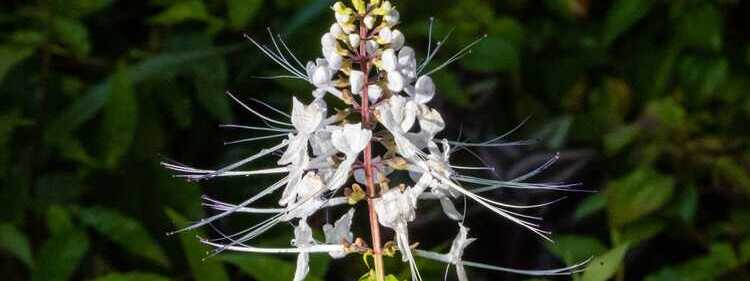
A marvellously intriguing plant, the Orthosiphon aristatus is native to the tropical rainforests and eastern coastal areas of Queensland. Thriving in a moist and warm environment, it’s easy to understand why this perennial was given the common name of Cat’s Whiskers as soon as you lay your eyes on it. Along the inflorescence that grows from the centre of the plant, Orthosiphon aristatus produces flowers with long, protruding stamens and filaments. that give them the distinct appearance of a cat’s whiskers.
Bearing white or light purple tubular flowers that measure around 2 to 3 cm in length, Cat’s whiskers bloom from summer until fall. The inflorescence can grow up to 30 cm tall and the plant itself often reaches around 2 metres upon maturity. Cat’s whiskers are considered fast-growing plants and once established, they continue growing, producing new stems and foliage year-round in tropical regions.
Being part of the mint family, the leaves of the Orthosiphon aristatus produce a minty scent when crushed. Its leaves are traditionally used for medicinal purposes, as they have anti-microbial and anti-inflammatory properties. They are used as diuretics for treating kidney and urinary tract conditions, high blood pressure, and in providing antioxidant protection.
24. Lolly bush (Clerodendrum floribundum)
In the early 19th century, when the botanist Robert Brown first described the lolly bush, he was unsure whether it had medicinal properties or not. Historically, this was one of the botanists’ main preoccupations when exploring and describing the species they came across. Consequently, due to the uncertain medicinal value of the plant, Brown named it Clerodendrum Floribundum, which roughly translates to “chance or fate tree” and “full of flowers” respectively.
Interestingly, while the lolly bush does indeed flower abundantly, it can either be a shrub, tree, or a climber depending on how it’s pruned and trained, and where it’s planted. However, in the wild, it naturally grows as a woody climbing vine. However, the unique shape and vibrant dark red colour of the lolly bush’s flowers are one of its most striking features.
Although small themselves, measuring only about 2.5 cm long, they grow in large clusters that can reach 10 to 15 cm in diameter, creating a dense display of bright red blooms. After blooming, the plant produces multiple prominent black or dark purple fruit known as drupe, which contain a single seed inside. Once the fruit ripens, it either falls or is eaten by birds to release the fruit for subsequent germination.
Native to the tropical rainforests of Queensland, the lolly bush can be propagated through cuttings or seed. While it can handle short dry periods once established, it does best in consistently moist conditions and needs to be regularly watered.
25. Thyme Honey Myrtle (Melaleuca thymifolia)
A gorgeous bloomer, the thyme honey myrtle bears abundant clusters of pink to purple flowers that look similar to brushes. It has a very long flowering period, which has been recorded to last from January to December. The plant produces flower spikes that can grow up to 3 cm or 5 cm in length, and the flowers are arranged in small heads along the stems.
The thyme honey myrtle gets its name from its leaves, which emit a spicy scent when crushed that’s similar to thyme. Like a number of other Melaleuca species, the leaves of the Melaleuca thymifolia contain essential oils that research shows have strong antibacterial properties. Native mainly to southeastern Queensland, this evergreen shrub commonly ranges from 0.3 metres to 1.5 metres tall and about 2 metres wide.
Once established, Thyme Honey Myrtle is drought-tolerant and requires little maintenance. Due to its eye-catching appearance and ability to thrive in a range of conditions, it has been bred to produce several different cultivars, including “Pink Lace”, which produces pink flowers, “White Lace”, which bears white flowers, and “Little Beauty”, which is more low-growing and compact in comparison.
Conclusion
Queensland is home to a spectacular array of unique native flowering plants that reflect the state’s rich natural heritage. Although less well-known outside of Australia, these species are an integral part of Queensland’s landscape and ecosystem, offering both aesthetic value and vital ecological services.
Interestingly, as you may have noticed, many of Queensland’s native flowers commonly produce purple and blue-coloured blooms. This is due to a pigment in those plants called anthocyanins and the purpose is to protect plants from excessive light, help them attract the attention of pollinators, and possibly keep predators at bay.
Unfortunately, the populations of some of these unique flowers are becoming vulnerable and endangered in the world due to habitat loss and over-harvesting. It is essential to preserve these species for conserving and maintaining the biodiversity and beauty of Queensland’s unique flora.

